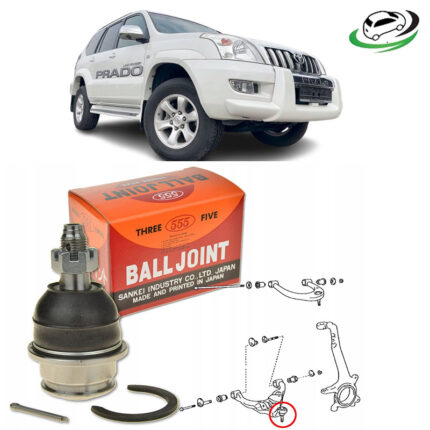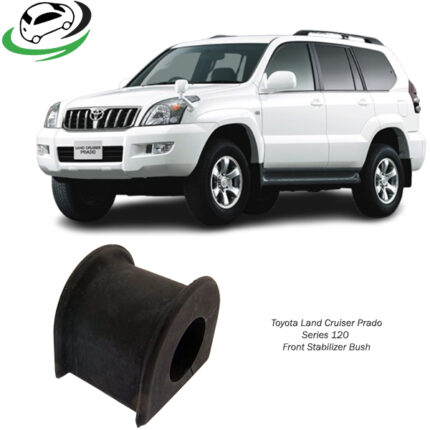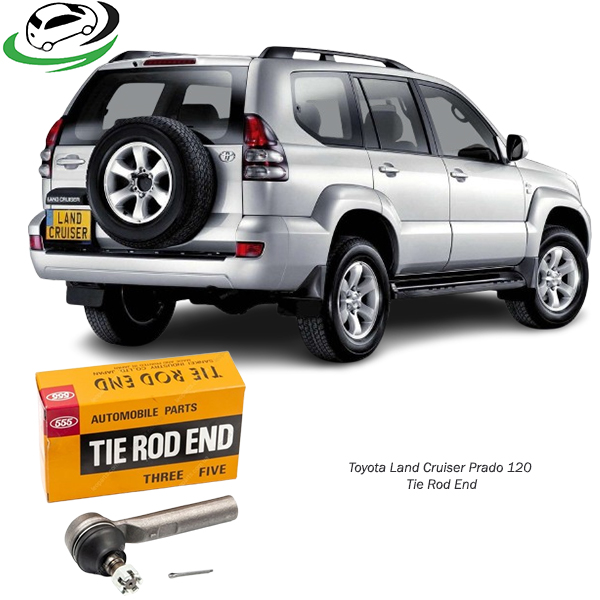-8%
Get Toyota Land Cruiser Prado 120 Series Tie Rod End Sub Assy Set R/L se3841
The Tie Rod End Sub Assembly Set, commonly known as the “tie rod end,” is a key component of the vehicle’s steering and suspension system. The “R/L” designation refers to both the right (R) and left (L) sides, as each side requires its own tie rod end. This component plays a critical role in maintaining alignment and ensuring smooth steering, which contributes to the overall handling and safety of the vehicle. Understanding the tie rod end’s structure, function, maintenance needs, and common signs of wear is essential for optimal vehicle performance.
1. Structure and Components of the Tie Rod End Sub Assembly Set (R/L)
The tie rod end assembly is part of the rack-and-pinion steering system, connecting the steering rack to the steering knuckle on each side of the vehicle. Each tie rod end assembly consists of the following parts:
- Inner and Outer Tie Rod Ends: The tie rod assembly typically includes an inner tie rod and an outer tie rod. The inner tie rod connects to the steering rack, while the outer tie rod connects to the steering knuckle. Together, they enable the transfer of motion from the steering rack to the wheels.
- Ball Joint: Each tie rod end has a ball joint that allows flexibility and pivoting motion. This joint enables the wheel to move up and down as it follows road contours, while also allowing left-to-right movement for steering.
- Threaded Adjustment Sleeve: The outer tie rod end is often connected to an adjustable sleeve that allows for precise alignment of the wheels. Adjusting this sleeve alters the length of the tie rod, which changes the wheel alignment.
- Protective Boot: The tie rod end assembly includes a rubber boot around the ball joint, which protects it from dirt, moisture, and debris, extending the life of the joint by keeping it lubricated.
2. Function of the Tie Rod End Sub Assembly Set (R/L)
The tie rod ends are crucial for translating the driver’s steering inputs into wheel movement. Here’s how they function:
- Transfer Steering Rack Motion: When the driver turns the steering wheel, the steering rack moves horizontally. The tie rod ends connect the steering rack to the wheels, allowing this horizontal movement to translate into a turning motion for the wheels.
- Maintain Wheel Alignment: Properly functioning tie rod ends help maintain precise wheel alignment, ensuring that the wheels stay parallel to each other. This alignment is vital for safe handling, even tire wear, and improved fuel efficiency.
- Absorb Road Shocks: The tie rod ends help absorb minor shocks and vibrations from the road, smoothing out the ride and providing a more comfortable driving experience.
- Allow Independent Wheel Movement: Thanks to the ball joints in the tie rod ends, each wheel can move independently, accommodating bumps, turns, and dips in the road. This prevents stress on the suspension system and keeps the ride smooth.
3. Benefits of a Well-Maintained Tie Rod End Sub Assembly Set (R/L)
Properly functioning tie rod ends offer a number of benefits, especially in terms of vehicle handling, safety, and tire longevity:
- Enhanced Steering Response: Healthy tie rod ends ensure that steering inputs are accurately transmitted to the wheels. This results in precise, responsive steering, giving the driver greater control.
- Improved Alignment and Reduced Tire Wear: Proper wheel alignment, which is maintained by the tie rod ends, ensures even tire wear. When the wheels are misaligned, tires wear unevenly and more quickly, which can be costly to replace.
- Fuel Efficiency: Misaligned wheels create rolling resistance, forcing the engine to work harder and consume more fuel. A properly aligned vehicle with good tie rod ends will roll more efficiently, helping improve fuel economy.
- Enhanced Vehicle Safety: Steering and stability are directly impacted by the tie rod ends. Compromised or worn tie rod ends can cause unstable handling, especially during cornering or sudden maneuvers, increasing the risk of accidents.
4. Common Signs of Worn or Failing Tie Rod Ends
Over time, tie rod ends can wear out due to constant exposure to the elements, vibrations, and road impacts. Here are some common signs of failing tie rod ends:
- Loose or Unresponsive Steering: Worn tie rod ends can cause “play” in the steering wheel, making it feel loose or less responsive.
- Uneven or Excessive Tire Wear: Misaligned wheels caused by worn tie rod ends will often lead to uneven tire wear, particularly on the inside or outside edges of the tire.
- Steering Wheel Vibration: As tie rod ends wear out, they may cause vibrations in the steering wheel, especially at higher speeds or during turns.
- Squeaking or Clunking Noises: Worn ball joints in the tie rod end can produce squeaking or clunking sounds, particularly when turning or going over bumps.
- Vehicle Pulling to One Side: A vehicle with misaligned wheels, often due to worn tie rod ends, may pull to one side, making it difficult to maintain a straight line.
5. Maintenance Tips for the Tie Rod End Sub Assembly Set (R/L)
To keep your vehicle’s tie rod ends in optimal condition and avoid costly repairs, follow these maintenance tips:
- Regular Inspection: Check the tie rod ends periodically for signs of wear, especially if you experience any of the symptoms mentioned above. Include tie rod inspection as part of regular maintenance, such as during oil changes or tire rotations.
- Keep Ball Joints Lubricated: Many tie rod ends are sealed and do not require additional lubrication, but if your vehicle’s tie rod ends have serviceable ball joints, ensure they are greased regularly.
- Protect the Rubber Boot: The rubber boot around the ball joint protects it from debris and moisture. Inspect these boots for cracks or tears, and replace them if necessary to prevent contaminants from entering the joint.
- Alignment Check: Have the vehicle’s wheel alignment checked regularly, especially if you’ve had any repairs done to the steering or suspension. A professional alignment can prevent unnecessary stress on the tie rod ends and extend their lifespan.
- Avoid Hitting Curbs and Potholes: Frequent impacts from curbs or potholes can damage the tie rod ends, causing misalignment and accelerating wear. Drive cautiously, and if you notice a sudden change in steering or alignment after hitting a pothole, have the suspension checked.
6. Replacement of the Tie Rod End Sub Assembly Set (R/L)
If the tie rod ends are worn beyond repair, replacement is necessary to restore safe handling and alignment. Here’s what you need to know about replacing tie rod ends:
- Replacement Process: Replacing tie rod ends involves removing the old ends and installing new ones. This requires specialized tools, like a tie rod puller, and knowledge of the suspension system, as well as a precise alignment adjustment afterward.
- Professional Assistance Recommended: While it’s possible to replace tie rod ends yourself, having a professional mechanic perform the replacement is advisable, as they can ensure correct installation and proper alignment.
- Alignment After Replacement: After replacing tie rod ends, an alignment check is necessary to ensure that the wheels are correctly aligned. Misalignment can cause rapid tire wear and unsafe handling.
7. Costs and Choosing Quality Tie Rod Ends
When replacing tie rod ends, selecting quality components is important to ensure longevity and optimal performance:
- Cost of Replacement: The cost of tie rod end replacement varies based on the vehicle make, model, and labor costs. Tie rod ends themselves may cost between $20 and $150 each, with labor adding another $100 to $200 per side.
- Choosing Quality Parts: High-quality tie rod ends last longer and provide better performance. Look for products from reputable brands with warranties, and consider OEM (Original Equipment Manufacturer) parts for the best fit and quality.
- Material and Build Quality: Many high-quality tie rod ends feature durable metal construction and use advanced ball joint designs to ensure better performance and longevity.
8. Benefits of Regular Maintenance and Quality Replacement Parts
Investing in quality tie rod ends and regular maintenance can significantly improve your vehicle’s performance, longevity, and safety:
- Smoother, More Controlled Steering: Replacing worn tie rod ends restores precise steering, improving vehicle control and reducing strain on other suspension parts.
- Extended Tire Life: Proper alignment from functional tie rod ends minimizes tire wear, saving money in the long run.
- Lower Repair Costs: Maintaining tie rod ends reduces the likelihood of related component failures, keeping repair costs down over time.
- Increased Safety and Comfort: Smooth steering and stable alignment increase driver confidence and overall comfort, enhancing the driving experience.
9. Conclusion
The tie rod end sub assembly set (R/L) is a vital component of your vehicle’s steering and suspension system. It plays a critical role in translating steering input into wheel movement, maintaining alignment, and absorbing road shocks. Proper maintenance, regular inspection, and timely replacement of worn tie rod ends ensure smoother handling, even tire wear, and enhanced safety. Investing in high-quality tie rod ends and following recommended maintenance practices will keep your vehicle performing optimally and help avoid costly repairs, making every journey more comfortable and secure.
Follow us on Facebook for more parts.



